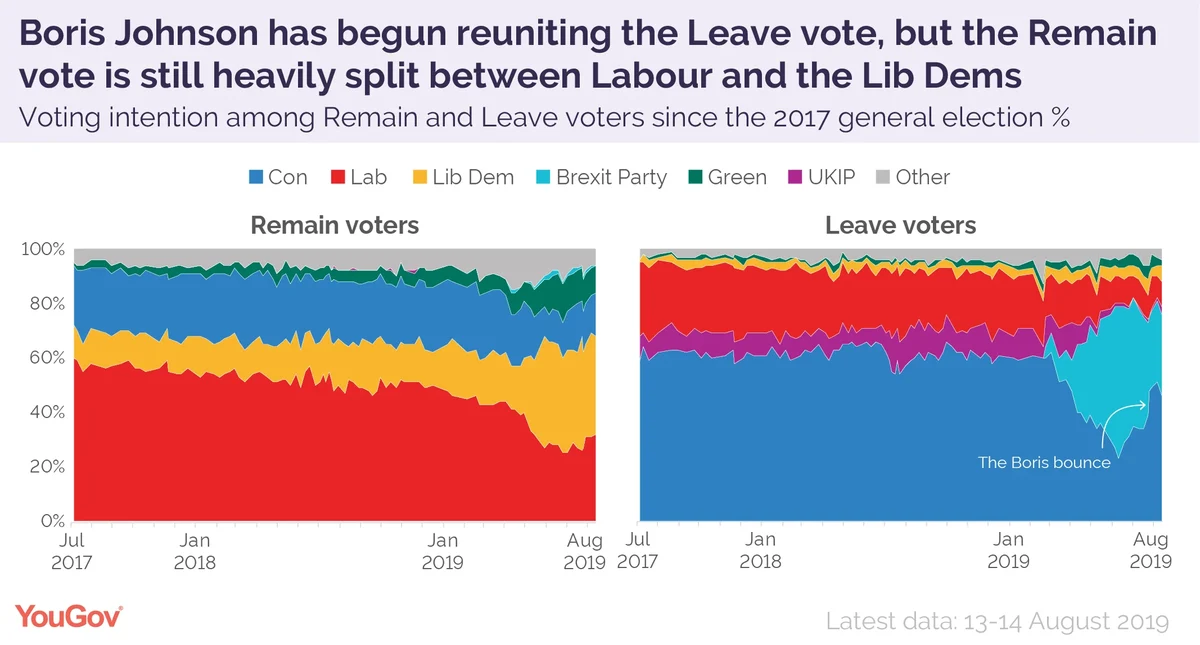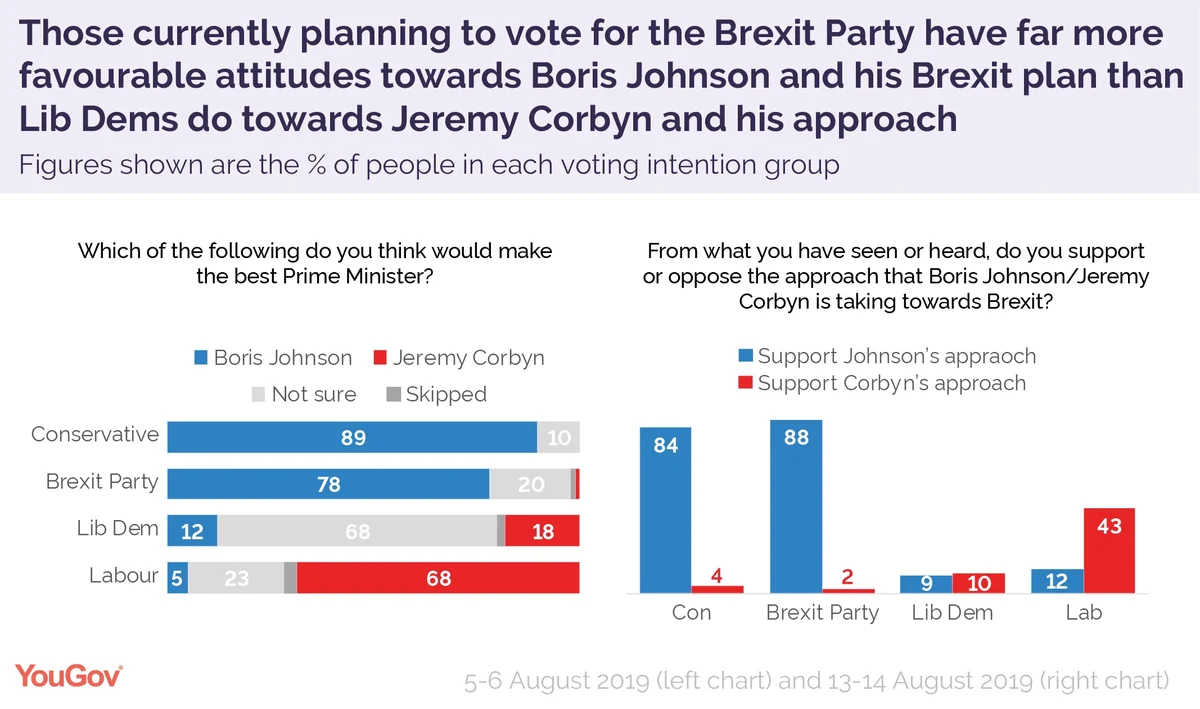If an early election is called the Conservatives would be in a strong position
At the 2017 general election we saw some Brexit realignment in how people voted, and this has only heightened since the European Parliament elections. Around three quarters of those who backed Brexit in 2016 now say they would vote for either the Brexit Party or Conservatives if there was a general election, while around two thirds of those who voted Remain pick either Labour or the Liberal Democrats.
Since becoming Prime Minister, Boris Johnson’s approach has been to wholeheartedly appeal to Leave voters – specifically those who have abandoned the Conservative party for the Brexit Party – with his pledge that the UK will leave the EU with or without a deal by the end of October. Many within his party have cautioned that alienating the Remain portion of the electorate like this could backfire, but now with an autumn election looking like a distinct possibility new YouGov data reveals that Johnson’s strategy could pay off as long as the Remain vote continues to be split.
The Conservatives have already reaped some of the rewards of this strategy, experiencing a “Boris bounce” almost entirely at the expense of the Brexit Party. In early June, twice as many Leave voters (56%) said they would back Farage’s party over the Tories (23%). Now, the Conservatives have 46% of the Leave vote, having whittled the Brexit Party vote down to 30% amongst this group.
By contrast, Labour and the Liberal Democrats have around a third of the Remain vote each, with the latter performing slightly better amongst this group. These figures have been fairly consistent since the Lib Dems’ success at the European Parliament elections and there are few signs that this will change. While Boris’s pro-Brexit position hasn’t won him any new fans on the Remain side, he also doesn’t seem to have lost many of those who still support the party either. All this leaves the Conservatives currently with a nine point lead in the polls, with Labour battling the Lib Dems for second place.
Having already inflicted some initial damage on the Brexit Party the Conservatives are well equipped to win over further voters from Nigel Farage, and current evidence suggests they have a have a better chance of winning over Leave voters than Labour have at increasing their Remain share.
Firstly, more than half of those who currently say they will vote for the Brexit Party backed the Conservatives in 2017, so are at least somewhat open to voting for the party. With the Brexit Party only being a few months old it may be that loyalty to the party is not particularly strong. In contrast, only around a third of Liberal Democrats voted Labour in 2017.
Secondly, those who currently say they would vote Brexit Party are very supportive of the new PM. More than three quarters (78%) of Brexit Party voters say they prefer Boris Johnson to Jeremy Corbyn, with just 1% preferring the Labour leader. Liberal Democrats have a very negative view of both leaders, with just 18% saying Corbyn would make the best PM, 12% Johnson and 68% refusing to pick either. They are also sceptical of Labour’s Brexit policies despite the party's recent move to supporting a second referendum. Fully 92% of Lib Dems say Labour’s policies on Brexit are unclear or confusing and only 10% are supportive of the leader when it comes to Brexit. In contrast, Johnson’s unambiguous position is very popular with those currently backing Farage’s party. In fact, the proportion of Brexit Party supporters who support the PM’s approach to Brexit is about the same as it is among current Conservative supporters (88% and 84%, respectively).
Finally, while First-Past-the-Post could be a problem for both the Liberal Democrats and Brexit Party, the former have much more experience of contesting and winning seats in such elections. After the 2017 general election was announced UKIP saw their vote share halve in just a week, so it is possible something similar could happen to the Brexit Party, particularly given the Conservatives appear to be an attractive alternative to these voters.
If the Conservatives hold on to and improve their vote share amongst Leavers nationally while Labour and Liberal Democrats continue to split the Remain vote, this could prove very fruitful for the Tories in not only Leave areas but also some Remain areas. In constituencies such as Canterbury or Kensington, where a majority voted to Remain in 2016, Labour managed to win seats off the Conservatives in 2017. If there is a national swing in the Remain vote share to the Liberal Democrats compared to 2017 the Conservatives could win these marginal seats back, despite these seats holding more Remain voters than Leave voters. The Tories may find it more difficult to hold on to Conservative-Liberal Democrat marginals, but these seats are far less numerous than Conservative-Labour marginals.
This whole analysis should come with a huge health warning that, in this politically volatile climate, voting intention could change significantly depending on how the Brexit process pans out. However, as things stand, the Conservatives look to be in a very strong position if there were to be a general election in the near future, largely because of their new leader’s ability to dominate the Leave vote while his competitors split the Remain vote.
Photo: Getty










